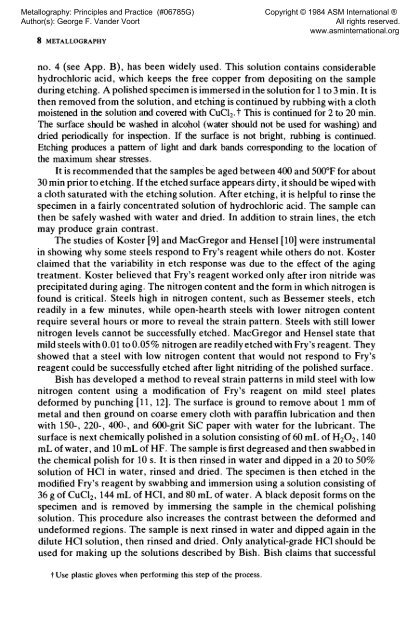Metallography: Principles and Practices - ASM International
Metallography: Principles and Practices - ASM International
Metallography: Principles and Practices - ASM International
You also want an ePaper? Increase the reach of your titles
YUMPU automatically turns print PDFs into web optimized ePapers that Google loves.
<strong>Metallography</strong>: <strong>Principles</strong> <strong>and</strong> Practice (#06785G)<br />
Author(s): George F. V<strong>and</strong>er Voort<br />
8 METALLOGRAPHY<br />
no. 4 (see App. B), has been widely used. This solution contains considerable<br />
hydrochloric acid, which keeps the free copper from depositing on the sample<br />
during etching. A polished specimen is immersed in the solution for 1 to 3 min. It is<br />
then removed from the solution, <strong>and</strong> etching is continued by rubbing with a cloth<br />
moistened in the solution <strong>and</strong> covered with CuCl2.t This is continued for 2 to 20 min.<br />
The surface should be washed in alcohol (water should not be used for washing) <strong>and</strong><br />
dried periodically for inspection. If the surface is not bright, rubbing is continued.<br />
Etching produces a pattern of light <strong>and</strong> dark b<strong>and</strong>s corresponding to the location of<br />
the maximum shear stresses.<br />
It is recommended that the samples be aged between 400 <strong>and</strong> 500°F for about<br />
30 min prior to etching. If the etched surface appears dirty, it should be wiped with<br />
a cloth saturated with the etching solution. After etching, it is helpful to rinse the<br />
specimen in a fairly concentrated solution of hydrochloric acid. The sample can<br />
then be safely washed with water <strong>and</strong> dried. In addition to strain lines, the etch<br />
may produce grain contrast.<br />
The studies of Koster [9] <strong>and</strong> MacGregor <strong>and</strong> Hensel [10] were instrumental<br />
in showing why some steels respond to Fry's reagent while others do not. Koster<br />
claimed that the variability in etch response was due to the effect of the aging<br />
treatment. Koster believed that Fry's reagent worked only after iron nitride was<br />
precipitated during aging. The nitrogen content <strong>and</strong> the form in which nitrogen is<br />
found is critical. Steels high in nitrogen content, such as Bessemer steels, etch<br />
readily in a few minutes, while open-hearth steels with lower nitrogen content<br />
require several hours or more to reveal the strain pattern. Steels with still lower<br />
nitrogen levels cannot be successfully etched. MacGregor <strong>and</strong> Hensel state that<br />
mild steels with 0.01 to 0.05% nitrogen are readily etched with Fry's reagent. They<br />
showed that a steel with low nitrogen content that would not respond to Fry's<br />
reagent could be successfully etched after light nitriding of the polished surface.<br />
Bish has developed a method to reveal strain patterns in mild steel with low<br />
nitrogen content using a modification of Fry's reagent on mild steel plates<br />
deformed by punching [11, 12]. The surface is ground to remove about 1 mm of<br />
metal <strong>and</strong> then ground on coarse emery cloth with paraffin lubrication <strong>and</strong> then<br />
with 150-, 220-, 400-, <strong>and</strong> 600-grit SiC paper with water for the lubricant. The<br />
surface is next chemically polished in a solution consisting of 60 mL of H202,140<br />
mL of water, <strong>and</strong> 10 mL of HF. The sample is first degreased <strong>and</strong> then swabbed in<br />
the chemical polish for 10 s. It is then rinsed in water <strong>and</strong> dipped in a 20 to 50%<br />
solution of HC1 in water, rinsed <strong>and</strong> dried. The specimen is then etched in the<br />
modified Fry's reagent by swabbing <strong>and</strong> immersion using a solution consisting of<br />
36 g of CuCl2, 144 mL of HC1, <strong>and</strong> 80 mL of water. A black deposit forms on the<br />
specimen <strong>and</strong> is removed by immersing the sample in the chemical polishing<br />
solution. This procedure also increases the contrast between the deformed <strong>and</strong><br />
undeformed regions. The sample is next rinsed in water <strong>and</strong> dipped again in the<br />
dilute HC1 solution, then rinsed <strong>and</strong> dried. Only analytical-grade HC1 should be<br />
used for making up the solutions described by Bish. Bish claims that successful<br />
tUse plastic gloves when performing this step of the process.<br />
Copyright © 1984 <strong>ASM</strong> <strong>International</strong> ®<br />
All rights reserved.<br />
www.asminternational.org
















